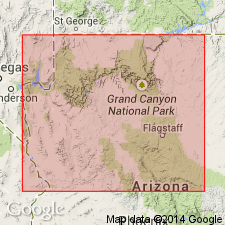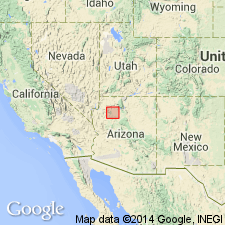
- Usage in publication:
-
- Blue Mountain gravel
- Modifications:
-
- Original reference
- Dominant lithology:
-
- Gravel
- AAPG geologic province:
-
- Plateau sedimentary province
Koons, Donaldson, 1948, Geology of the eastern Hualpai Reservation: Plateau, v. 20, no. 4, p. 53-60.
Summary:
Pg. 54 (fig. 1), 58. Blue Mountain gravel. Bedded deposits of well-rounded pebbles and cobbles of granite, gneiss, schist, and red and white quartzite, up to 20 inches in the long diameter. Deposits generally deeply weathered. Maximum measured thickness 150 feet, but generally somewhat thinner. Found at elevations ranging from 5,775 feet near Blue Mountain to 7,125 feet near the Pinnacle. Age is Quaternary.
Named from Blue Mountain, Coconino Co., northwestern AZ, where formation is well exposed.
Source: US geologic names lexicon (USGS Bull. 1200, p. 399).

- Usage in publication:
-
- Blue Mountain Gravel
- Modifications:
-
- Not used
Summary:
Gravel deposits at Blue Mountain, Coconino Co, AZ, Plateau sedimentary province, previously assigned to Blue Mountain Gravel (not used) by author (Koons, 1948) are here assigned to Frazier Well Gravel. Blue Mountain Gravel not used anywhere on geologic map (fig. 2). [Though a type area was not designated by Koons (1948) for Blue Mountain Gravel, the fact that it is not used in the area for which it was named effectively abandons the name Blue Mountain Gravel.]
Source: GNU records (USGS DDS-6; Denver GNULEX).
For more information, please contact Nancy Stamm, Geologic Names Committee Secretary.
Asterisk (*) indicates published by U.S. Geological Survey authors.
"No current usage" (†) implies that a name has been abandoned or has fallen into disuse. Former usage and, if known, replacement name given in parentheses ( ).
Slash (/) indicates name conflicts with nomenclatural guidelines (CSN, 1933; ACSN, 1961, 1970; NACSN, 1983, 2005, 2021). May be explained within brackets ([ ]).

